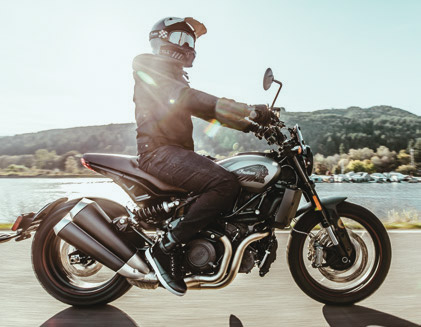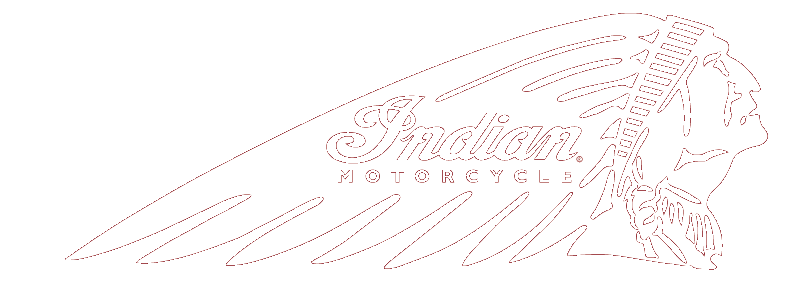THE 1200 LOOKS LIKE A CLOSE RELATIVE OF THE 750—THE STOCKY COUSIN WHO SPENDS EVERY NIGHT IN THE GYM.
RICH CHRISTOPH, INDIAN MOTORCYCLE’S SENIOR INDUSTRIAL DESIGNER, WELCOMED JARED MEES, THE NEWEST RACER ON THE COMPANY’S NEXT-GENERA-TION WRECKING CREW TEAM, INTO HIS SHOP.
He showed Mees a clay buck—a full-size model of the motorcycle body that would become Indian’s FTR 750, a bike built from fork to clutch for flat track racing. Mees used the buck like a real bike, shifting side-to-side, leaning and tucking flat. As he did, Christoph scraped off clay beneath him, narrowing the frame, extending it. When Mees showed how he slides from the tank to the tail during turns, Christoph pulled out a looped-wire tool and whittled down the protrusions that would get in the way. Later, when Mees pressed flat against the bike, eliminating air resistance, Christoph noticed that Mees’s chest might seal off a crucial air intake. So he designed a pocket for the filter that would maintain airflow even if it were covered. It was the first time in decades someone was building a bike explicitly for flat trackracing. And as the clay model neared completion, Christoph already had another big idea forming: how this race bike could be turned into a street bike.
Adapting a stripped-down dirt bike for city streets wouldn’t be easy. The FTR 750 has no lights, for one thing. No starter. Its one-gallon tank provides a range of 25 miles. And its mufflers would get street riders a ticket every time they fired the bike up. But Indian Motorcycle had a secret weapon to draw upon: the design language and history of Indian Motorcycle. It also had some clever engineering. The problem solving started directly below the rider. What appears to be the fuel tank on the FTR 1200 is actually the airbox. “Rich had this vision that the top line of the bike would maintain some commonality with the race bike,” says Matt Fronk, platform manager for international motorcycles. “We had to really put a lot of effort into making sure it still had that silhouette while maintaining the airbox volume, which we needed to get the power we wanted.” They moved the fuel tank under the seat and used a plastic cover to disguise the sleight-of-hand. “That’s the fun of the back-and-forth,” says Fronk.
“Rich has got more of the artistic view, and when it comes to my team, it’s like, figure out how to put 10 pounds in a five-pound bag. Good luck!”
The biggest challenge—because it so fundamentally defines how the bike looks and handles—was getting the frame right. The chassis team wanted a trellis frame with a short wheelbase, like the 750. But the engine they were using, from the Scout line, was much bigger than the one on the 750.
2020 FTR 1200 S
73 CU IN. /1203cc
123 HP @ 8250 RPM
87 LB.FT AT 6000 RPM
How is the FTR 1200 S different from the FTR 1200? It comes with three ride modes—sport, standard, and rain—and a fully adjustable front and rear piggyback shock suspension. The S also has a high-visibility 4.3-inch customizable Ride Command LCD touchscreen with Bluetooth that lets you easily pair it with your mobile device. Available colors include Indian Motorcycle Red over Steel Gray, Titanium Metallic over Thunder Black Pearl, and Race Replica.

FTR 1200 Rally
The 2020 FTR Rally builds on the 2019 FTR design framework but adds authentic retro styling to the modern performance capabilities riders expect.
Sure to turn heads at every light and every intersection, the FTR Rally features Titanium Smoke paint with the Indian Motorcycle headdress logo, aluminium wire wheels with red pinstripe, brown aviator seat, a new rally windscreen and Pirelli Scorpion Rally STR tires.
“We had to come up with a method to take that existing engine and let it work as a structural member, without the traditional cradles like you have on a cruiser,” says senior project engineer Dave Bagnariol. “We ended up having to punch a hole through the crankcase of the engine so we could run the swingarm pivot through there.” And with that, a bike with the compact frame of a racer had the big engine of a road bike.
Side by side, the 1200 looks like a close relative of the 750—the stocky cousin who spends every night at the gym. You can see the shared DNA, the compactness, the way the tail of the bike leads your eye off into the distance. The tires are similar too, designed to have the aesthetic of a dirt tire, with the performance elements you need to stay upright on pavement.
Just as important as maintaining the look of the 750, however, was keeping the spirit.


Leave a Reply